Cherry shrimp, scientifically known as Neocaridina davidi, are a popular choice among aquarists due to their vibrant colors and hardy nature.
These small, freshwater invertebrates originate from Taiwan, and they have gained popularity across the world because of their ease of care and ability to thrive in various aquarium setups.
Cherry shrimp not only add visual interest to an aquarium but also play an essential role in keeping it clean by feeding on uneaten food and algae. As part of the Atyidae family, cherry shrimp come in various colors and patterns.
The most common variety is the red cherry shrimp with its bright red hue. However, cherry shrimp can display other colors, including blue, yellow, green, and more, depending on their specific variety and lineage.
Each variety has a unique appearance, behavior, and care requirements, making this diverse group a fascinating subject for any aquatic enthusiast to explore.
In their natural habitat, cherry shrimp can be found in shallow, freshwater environments with plenty of hiding spots, such as leaf litter and aquatic plants.
This preference also extends to their ideal home aquarium setup, where they require appropriate water parameters to support their health and growth.
Cherry shrimp are the ideal option for any hobbyist who wants to start getting into the world of the neocaridina shrimp species. They are generally very hardy and do not require any extra special or overly complicated water parameters.
While caring for cherry shrimp is relatively straightforward, understanding their specific needs in terms of diet, tank mates, and breeding is essential to ensuring their long-term well-being and success within an aquarium community.
Contents
1. Cherry Shrimp Overview
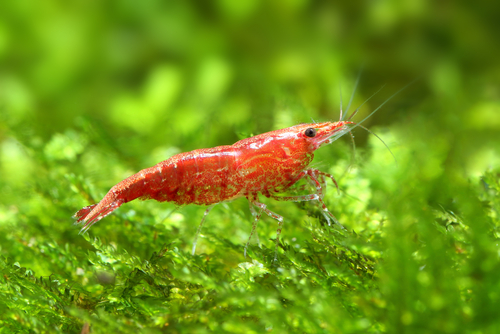
Cherry shrimp, scientifically known as Neocaridina davidi, are a popular choice among freshwater aquarium enthusiasts. They originate from Taiwan and are admired for their vibrant coloration, which ranges from pale pink to deep red.
These small, attractive creatures usually grow to a maximum length of about 1.5 inches, making them suitable for a variety of aquarium sizes.
Cherry shrimp are easy to care for, as they can tolerate a wide range of water parameters and temperatures. They are also efficient scavengers, helping to keep the aquarium clean by consuming algae and debris.
In addition to being low-maintenance, cherry shrimp are known for their peaceful and social nature. They make excellent additions to community aquariums containing a variety of other small, non-aggressive fish species.
However, they should be kept in groups of at least ten individuals to ensure they remain active and feel secure in their environment. Cherry shrimp also serve as a sustainable food source for larger aquarium inhabitants, such as fish and invertebrates.
They reproduce easily in captivity, with females carrying their eggs until they hatch into small, fully-formed shrimp. This ensures a continuous supply of food, without the need for frequent restocking.
In summary, cherry shrimp are a versatile and appealing option for aquarists of all experience levels. Their striking appearance, hardiness, and compatibility with various tank mates make them a highly sought-after choice for freshwater aquariums.
2. Classification and Varieties
There are various color variants that have been selectively bred from the wild-type Neocaridina davidi. The following paragraphs detail some of the most sought-after cherry shrimp varieties.
Red Cherry Shrimp
These are the most common and widely-available variety.
They come in different grades, with the saturation of red increasing from low-grade (transparent with little red) to high-grade (solid, intense red). The grades include Fire Red, Painted Fire Red, and Sakura Shrimp.
Orange and Yellow Cherry Shrimp
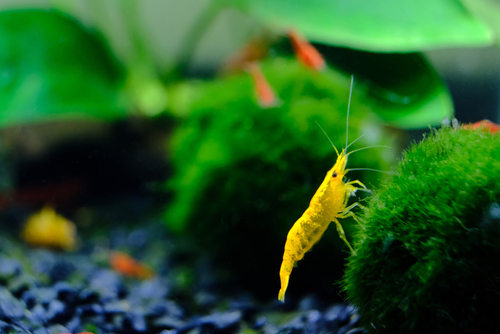
They are two distinct color varieties that exhibit bright orange and yellow hues, respectively. These colorful shrimp can bring a unique contrast to planted aquariums and are relatively easy to breed.
Green and Blue Cherry Shrimp
Green and blue cherry shrimp have been gaining popularity among aquarists in recent years. The Blue Velvet and Green Jade varieties, in particular, are known for their lively blue and green colors.
It is worth noting that the intensity of their coloration varies, with some specimens appearing more translucent than others.
Red Rili Cherry Shrimp

These are characterized by their distinct “rili” or segmented color pattern. Their bodies typically showcase a mix of transparent and colored segments, with the most common type displaying a vibrant red hue. However, Rili shrimp can also be found in other colors, such as blue and yellow.
Chocolate and Bloody Mary Cherry Shrimp
These are two unique color variants with nearly solid, dark exteriors. Chocolate shrimp exhibit a deep brown color, while Bloody Mary shrimp showcase an intense, dark-red coloration.
To summarize, cherry shrimp come in a multitude of colors and patterns, providing hobbyists with ample opportunities to add visual interest to their aquariums. Each of these varieties has its own charm, making cherry shrimp an attractive and popular choice for enthusiasts around the world.
3. Appearance and Coloration
The red coloration is due to their semi-transparent exoskeleton that exhibits various shades of red, depending on several factors such as age, diet, and genetics.
There are several color morphs of cherry shrimp, each displaying a different hue or pattern. Some common color morphs include:
- Red: The classic and most popular color among cherry shrimp enthusiasts.
- Blue: A less common color morph, displaying a blueish hue mixed with red.
- Yellow: A vibrant yellow morph that brings a pop of color to any aquarium.
- Green: A rare color morph, exhibiting shades of green mixed with red.
- Black: An even rarer color morph, displaying a black body with some red highlights.
In addition to these main color morphs, there can be variations of each one, resulting in a vast diversity of cherry shrimp appearances. Cherry shrimp can also be found with stripes, spots, or other distinct markings on their bodies.
Male and female cherry shrimp exhibit slight differences in appearance and coloration. Generally, female cherry shrimp are larger and more vibrant in color than their male counterparts.
The female’s exoskeleton may also be thicker, making the color appear more intense. Males, on the other hand, are usually smaller in size and have a more slender appearance, with less pronounced coloration.
4. Natural Habitat

Cherry shrimp, are found in various parts of Asia fresh water lakes and rivers. Their natural habitats include slow-moving streams, ponds, and rivers in countries such as Taiwan and China.
The water in these ecosystems is typically freshwater, which is essential to the shrimp’s survival. Cherry shrimp prefer a stable environment with clear water, temperatures ranging from 22°C to 26°C (72°F to 79°F), and a pH level between 6.5 and 7.5.
These conditions help the shrimp to thrive and maintain their vibrant coloration. In their natural habitat, cherry shrimp consume a variety of food sources.
These can include biofilm, algae, and decaying plant matter, which contribute to a balanced diet and play a crucial role in their development and reproduction.
Their surroundings often consist of abundant vegetation and various hiding spots, such as rocks or branches, which provide the shrimp with shelter and protection from predators.
This environment also allows cherry shrimp to socialize, form communities, and establish territories, indicating their preference for a more densely populated habitat.
Cherry shrimp are known for their adaptability and resilience in various water conditions, making them a popular choice for home aquarists.
However, preserving aspects of their natural habitat, such as water parameters and hiding spots, is still essential for their health and well-being within an aquarium setting.
5. Home Aquarium Setup
Cherry shrimp thrive in a well-maintained aquarium with stable water parameters. Starting with the tank, a minimum size of 5 gallons (Typically 20 liters) is recommended for these small creatures.
However, larger tanks are preferable, as they provide more room for the shrimp population to grow and are easier to maintain stable water conditions.
When setting up the aquarium, make sure to choose a suitable substrate for these shrimp. A dark-colored gravel or sand substrate not only enhances the shrimp’s colors but also provides a suitable environment for them to forage among the particles.
Adding live plants, such as java moss or java ferns, will also benefit cherry shrimp by offering them hiding spaces and additional food sources.
Water parameters play a critical role in the health and survival of cherry shrimp. The ideal water temperature for these shrimp is 72-78°F (22-25°C), so it might be necessary to use a heater to maintain a consistent temperature.

pH should range from 6.5 to 7.5. Regular monitoring of ammonia, nitrite, and nitrate levels is crucial, as any sudden fluctuations can stress out and harm the shrimp population.
Here’s a brief overview of the ideal cherry shrimp tank conditions:
- Tank size: 5 gallons minimum or 20 liters
- Substrate: Dark-colored gravel or sand
- Water temperature: 72-78°F (22-25°C)
- GH: 6-8
- KH: 1-4
- pH: 6.5-7.5
- Ammonia, Nitrite, and Nitrate: Maintain stable levels
Several aspects of the tank setup can help maintain these optimal water parameters. Regular water changes, ranging from 10% to 25%, help keep ammonia, nitrite, and nitrate levels in check. A good amount of aquarium plants of any type also go a long way in keeping these levels in check.
Including a filter in the tank not only removes debris but also provides a vital part of the nitrogen cycle. Just make sure the filter’s flow rate is not too strong, as cherry shrimp prefer a calm environment. Ideally an appropriated sized sponge filter based on the tank volume will work perfectly in this case.
6. Cherry Shrimp Behavior
Cherry shrimp are known for their peaceful and non-aggressive behavior, which makes them ideal inhabitants for community aquariums. They spend most of their time scavenging for food, including algae and detritus, thus contributing to the cleanliness of their environment.
An essential aspect of cherry shrimp behavior is their molting process. During their life, they undergo several molts to grow properly. When molting, these shrimp shed their exoskeleton, revealing a soft and vulnerable new shell. It is typical for the cherry shrimp to hide and stay less active during this time until their new exoskeleton hardens.
Cherry shrimp exhibit interesting swimming patterns as well. Although they are predominantly bottom dwellers, they occasionally swim vertically in bursts, displaying a fascinating behavior known as “darting.”
This type of movement is usually associated with their efforts to escape from threats, seek out food, or explore new territories within the aquarium..
7. Feeding Your Cherry Shrimp

Cherry shrimp are not picky eaters, and providing them with a balanced diet is crucial to keeping them healthy and active. A mix of shrimp food, vegetables, and algae is ideal to ensure they receive the necessary nutrients for growth and reproduction.
Shrimp food is readily available in various forms, such as pellets and flakes, which are specifically formulated to meet their dietary requirements. Feed cherry shrimp in small amounts, as overfeeding can lead to poor water quality and can be detrimental to their health especially in smaller tanks.
In addition to shrimp food, supplementing their diet with fresh vegetables is highly beneficial. Vegetables like blanched zucchini are a popular choice, rich in essential vitamins and minerals. They will also enjoy snacking on pre-cooked carrot slices as well as green beans. both of these 2 vegetables will last at least 3 days in your tank before having to be removed if they are not completely devoured by day 3.
Ensure that any vegetables offered are thoroughly cleaned and prepared appropriately to avoid introducing harmful substances into the tank. Typically putting them into a suitable microwave proof bowl and pouring over boiling water and cooking on high in the microwave oven for between 5 to 10 minutes will ensure they are safe to feed and they will also naturally sink. You can also make a larger batch and freeze some so you will always have on hand to feed them.
Algae also play a significant role in the diet of cherry shrimp. These crustaceans naturally graze on algae and biofilm present in the aquarium. Biofilm is a thin layer of microorganisms that forms on surfaces within the tank.
It acts as a rich source of nutrients for shrimp, while also helping to maintain water quality. Encouraging the growth of biofilm and algae in the tank provides a sustainable, natural food source for cherry shrimp.
For those with limited algae growth or larger shrimp populations, algae wafers can be provided as an alternative. Algae wafers are commercially available and can be broken into smaller pieces for the shrimp to consume.
This will help ensure that they continue to receive the necessary nutrients from algae without relying solely on naturally occurring sources.
By providing cherry shrimp with a diverse diet consisting of shrimp food, vegetables, and sources of algae, you can ensure they thrive in their aquarium environment.
Maintain a consistent feeding schedule and monitor the shrimp’s behavior and response to different food types to properly cater to their dietary needs.
8. Tank Mates
Cherry shrimp are peaceful and friendly creatures that can easily coexist with various tank mates. However, it is important to select tank mates carefully to ensure a safe and comfortable environment for the shrimp. In this section, we will discuss some suitable tank mates for cherry shrimp.
Small and non-aggressive fish are ideal companions for cherry shrimp. Species such as neon tetras, guppies, and rasboras can be good options, as they are less likely to view cherry shrimp as prey.
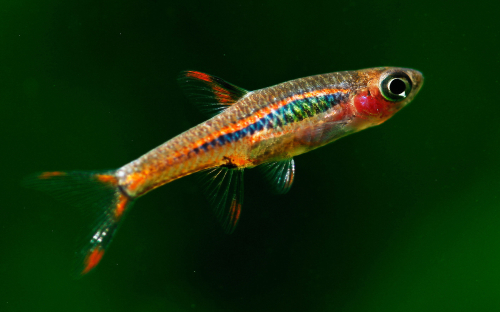
However, it is advisable to avoid larger and more aggressive fish like cichlids and angelfish, as they may pose a threat to the shrimp.
Ghost shrimp and Amano shrimp are other popular choices for tank mates. These species of shrimp are also peaceful and can coexist well with cherry shrimp. They share similar requirements for water parameters and diet, making them compatible tank mates.
Snails, such as Nerite snails and Malaysian trumpet snails, are also excellent tank mates for cherry shrimp. They help maintain the aquarium’s cleanliness, consuming algae and leftover food particles.
Their is also a “myth” that assassin snails cannot be put in with shrimp as they will eat the shrimp. Well as the word already describes this, it is a “myth” and assassin snails are perfectly safe with cherry shrimp.
Additionally, snails are generally non-aggressive, ensuring a safe environment for both shrimp and other inhabitants.
9. Breeding Cherry Shrimp
Breeding cherry shrimp is relatively straightforward, making them a popular choice for hobbyists looking to start a shrimp colony. They are prolific breeders, which can result in a thriving population in a short period. Its basically like “plug and play”!
To stimulate breeding, it is essential to maintain stable water conditions and provide a well-balanced diet to keep the shrimp healthy. The use of high-quality shrimp food, suitable water parameters, and a clean tank will significantly help improve breeding success.
Also the tank and their environment should not be fiddled with or changed in any drastic way as this they prefer consistency and regularity especially when it comes to breeding.
When it comes to breeding, cherry shrimp follow a unique process of carrying eggs. The females can be easily identified by their more robust and colorful appearance.
When a female is ready to mate, she releases pheromones into the water which attracts nearby males. After mating, a berried female carries her fertilized eggs under her tail for about 3 to 4 weeks. These eggs appear as clusters, which give the shrimp the name “berried.”
During this period, it is crucial to avoid stressors, such as poor water conditions or aggressive tank mates, to prevent the female from dropping or consuming the eggs.
Hobbyists often employ selective breeding to enhance the shrimp’s coloration and create new color strains.
This process involves isolating shrimps with desired traits and allowing them to breed, focusing on those that display vivid red coloration for cherry shrimp. Patience is necessary, as breeding for better color might require several generations.
Establishing a thriving cherry shrimp colony poses numerous benefits, including natural algae control and aesthetically pleasing tanks. By providing the necessary care and conditions, cherries will breed abundantly, populating your tank with vibrant and charismatic invertebrates.
10. Cherry Shrimp Health
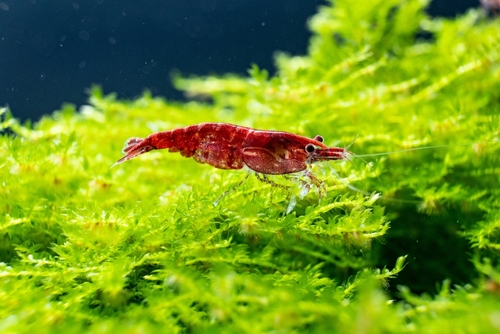
To maintain optimal health for these colorful creatures, it is essential to understand their specific needs and preferences.
A key aspect of cherry shrimp health is the molting process, during which the shrimp shed their old exoskeletons to make way for new growth. Molting is a natural and necessary part of their life cycle, and a sign that the shrimp is healthy.
However, inadequate water quality or lack of necessary nutrients can lead to molting issues. To prevent such problems, it is crucial to maintain good water quality, including appropriate pH levels, temperature, and filtration.
In addition to clean water, cherry shrimp require an adequate supply of calcium and minerals that contribute to the development of a strong exoskeleton.
A lack of these essential nutrients can lead to weak exoskeletons, making the shrimp more prone to injury and molting complications.
Providing a diet rich in sources of calcium and minerals, such as calcium blocks or mineral supplements, is an effective way to ensure that the shrimp receive the necessary nutrients.
Water quality plays a vital role in cherry shrimp health. Poor water quality can lead to stress, diseases, and increased mortality rates.
A well-maintained aquarium with appropriate water parameters, including stable pH and temperature, can help in preventing such issues. Regular water changes and testing of water parameters can ensure optimal living conditions for the shrimp.
11. Caring for Cherry Shrimp
Caring for cherry shrimp is a rewarding experience for both beginner and advanced aquarists, as these colorful creatures are easy to maintain and add visual interest to aquariums. Providing a suitable environment for cherry shrimp involves a few simple steps and considerations.
Start by selecting appropriate plants and decorations. Java moss is a popular choice, as it provides excellent coverage for cherry shrimp to move around and stay hidden.
Additionally, driftwood and other pieces of natural décor create hiding places for shrimp, offering them a safe and secure environment.
Water quality is another crucial aspect of cherry shrimp care. Ensure that the aquarium’s water parameters are within the appropriate range for these creatures.
A sponge filter is recommended for maintaining a shrimp-friendly environment, as it provides gentle water flow and reduces the chances of sucking shrimp into the filter.
Sponge filters are also beneficial because they house beneficial bacteria that break down harmful substances in water and help maintain a healthy environment for the shrimp.
Feeding cherry shrimp a varied diet of high-quality shrimp pellets, blanched vegetables, and other invertebrate foods promotes their health and vibrant coloration.
While they can consume algae and other detritus in the aquarium, supplementing their diet ensures they receive adequate nutrition.
12. Purchasing Cherry Shrimp
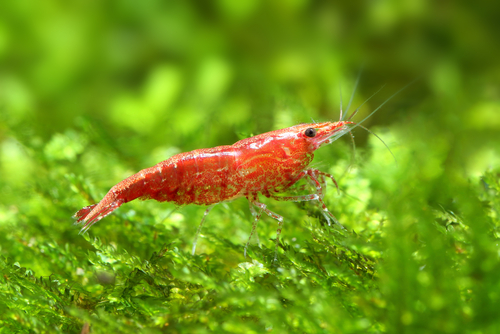
When buying cherry shrimp, it is important to be well-informed and discerning. The first step in purchasing cherry shrimp is to research reputable aquarium stores and online vendors.
Look for sellers with a strong reputation and positive reviews to ensure that the shrimp are healthy and well-adapted to living in a tank environment.
Cherry shrimp are priced reasonably, making them a popular choice among beginners. The cost can range from $2 to $6 per shrimp, depending on factors such as size, color, and grade.
Keep in mind that purchasing higher-grade cherry shrimp may require a larger initial investment, but can provide a more visually appealing display in the tank.
In terms of quantity, it is recommended to start with at least 10 cherry shrimp for beginners. This group size helps establish a stable population and enables optimal observation of their behavior, while providing an appropriate level of challenge for those new to shrimp-keeping.
When it comes to the actual transaction, make sure to inquire about the following:
- Shrimp health: Inspect the shrimp to ensure they are active and show no signs of illness, such as lethargy or discoloration.
- Water parameters: Confirm that the shrimp have been kept in optimal water conditions, with ideal parameters being a pH of 6.5 to 7.5, a temperature of 72 to 78°F, and a gH of 6 to 8.
- Diet: Ensure that the shrimp have been fed a balanced diet including algae, blanched vegetables, and shrimp-specific pellets or flakes.
By being diligent and informed during the purchasing process, shrimp enthusiasts can successfully buy cherry shrimp that thrive in a home aquarium setting.
Remember to prepare the tank adequately before introducing the shrimp, including proper filtration, cycling, and planting, to further guarantee their health and well-being.
13. Acclimating New Cherry Shrimp
When introducing new cherry shrimp to your tank, ensure to follow the cherry shrimp care guide. It’s crucial to acclimate them gradually to prevent shock from parameter changes. Float their unopened bag in the tank for 20-30 minutes to equalize temperatures.
Then open the bag and add small amounts of tank water every 10-15 minutes for at least an hour. Matching pH as closely as possible and using drip acclimation over several hours is ideal for sensitive shrimp. Take your time and monitor how they react.
14. How to care for cherry shrimp optimally
When it comes to how to care for cherry shrimp, there are some key things to keep in mind. Cherry shrimp need an established tank if you want them to thrive. Set up a planted tank and let it cycle for at least 6 weeks before adding any shrimp.
This allows beneficial bacteria to grow to help keep the water clean. Cherry shrimp prefer soft, acidic water with a pH between 6.5-7.5, which is very important for them. Use driftwood, peat moss, or an RO system to naturally lower pH. Regular testing of water parameters is crucial.
Cherry shrimp are small and vulnerable to aggressive fish. Small community fish like neon tetras or rasboras make the best tankmates. Or you can keep cherries by themselves. Provide plenty of hiding spots with plants and cholla wood.
Supplement their diet with blanched veggies and sinking pellets. With optimal tank conditions, cherry shrimp will readily breed. Culling excess juveniles helps control populations. Give them a mature, planted tank, soft water, hiding places, and quality foods.
15. Grading System
The grading system categorizes shrimp based on color saturation. Lower grades appear pale or clear, while higher grades display deep, opaque color.

Grades include Clear/Sakura for translucent shrimp, Fire Red for partial color, and Painted Fire Red for complete opaque red coverage. Premium grades like Pinto and No Entry exist for exceptional specimens.
16. Emergency Care
Ensure cherry shrimp care by always isolating and quarantining injured or sick shrimp in a small hospital tank with ideal parameters and aquarium salt. Reduce stressors and use medications if necessary. Replace 50% of water daily. If an outbreak occurs, quarantine the entire colony and treat the main tank.
17. Appropriate Lighting
Moderate lighting between 50-80 lumens per square foot allows shrimp to display their best coloration. Use 6500K white light or RGB lighting to bring out vivid red hues.
Avoid direct sunlight. Provide shaded areas and floating plants for retreats if needed. Follow natural photoperiods.
Conclusion
Cherry shrimp are vibrant freshwater creatures that make excellent additions to community aquariums. Their hardiness, peaceful nature and ability to thrive in a range of conditions make them ideal for beginner and expert aquarists alike.
By providing a properly cycled tank with hiding spots, moderate lighting, stable water parameters, and a nutritious diet, you can breed shrimp that will readily display their full-color potential.
Following their basic care guidelines, you can continue to enhance your cherry shrimp breeding for years to come. With appropriate planning and setup, cherry shrimp offer an accessible and rewarding aquarium experience.
Frequently Asked Questions
What is the ideal tank setup for cherry shrimp?
Cherry shrimp thrive in a well-planted tank with hiding spots, such as mosses and small caves. A 10-gallon (40 liters) aquarium is a good starting size. They do well with gentle water flow and well-oxygenated water.
A sponge filter may provide adequate filtration while safeguarding the shrimp from being sucked in.
How long is the lifespan of a cherry shrimp?
The average lifespan of cherry shrimp is 1-2 years. However, it can vary depending on their environment, diet, and water conditions. Providing them with a proper setup and maintaining stable water parameters will help them live longer.
What water temperature do cherry shrimp thrive in?
Cherry shrimp prefer temperatures in the range of 72-78°F (22-25°C). Consistent temperature levels are essential, so it is recommended to use a heater to maintain stable conditions. Sudden fluctuations in water temperature can stress the shrimp and negatively impact their health.
Are cherry shrimp compatible with other aquarium species?
Yes, cherry shrimp are compatible with many peaceful fish and invertebrate species. They can be kept with small, low-aggression fish, such as tetras or guppies. Aggressive or larger fish that could see them as a food source should be avoided.
How many cherry shrimp should be kept together in a tank?
To create a healthy and thriving cherry shrimp community, it is recommended to start with at least 10-12 shrimp. Because they are social creatures, they do best when kept in groups. The more shrimp you have, the more comfortable they’ll feel and the more likely they’ll breed.
Do cherry shrimp prefer fresh or saltwater environments?
Cherry shrimp must be kept in freshwater environments. Maintain water parameters such as pH (6.5-7.5) to help your cherry shrimp thrive in their aquarium habitat.
Do Cherry Shrimp Breed Easily?
If you’re considering keeping cherry shrimp, you’ve likely wondered if they’ll breed readily in your aquarium. The short answer is yes – under the right conditions, cherry shrimp breed extremely easily!
Key Takeaways on Cherry Shrimp Care
- Cherry shrimp are popular, hardy freshwater invertebrates known for their vibrant colors and contribution to aquarium cleanliness.
- These shrimp come in various colors and patterns, each requiring unique care and understanding to thrive.
- Ideal aquarium setups for cherry shrimp mimic their natural habitat and cater to their requirements in terms of water parameters, diet, and suitable tank mates.
You may also like these other popular posts:

Veteran fish keeper and keen hobbyist with a serious case of MTS. My midlife crisis was the establishment of a fish room, much to my wife’s horror. Little does she know it could be worse!!


